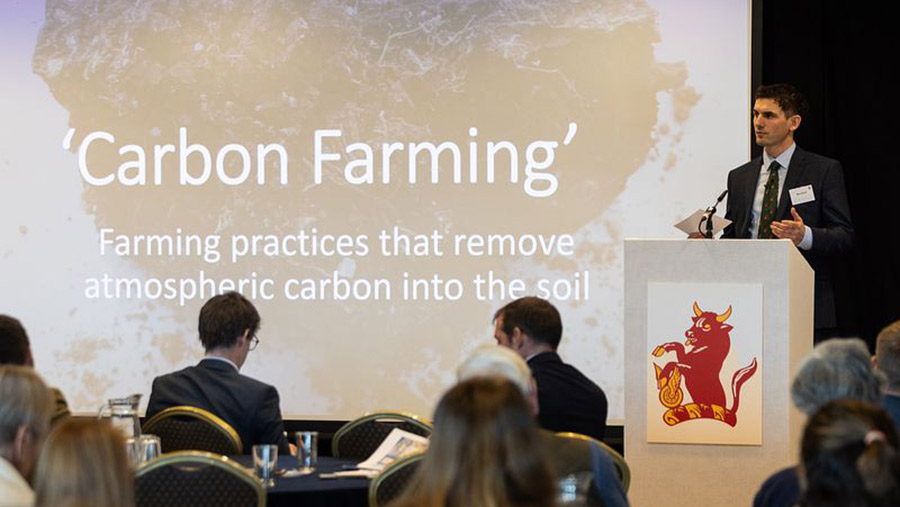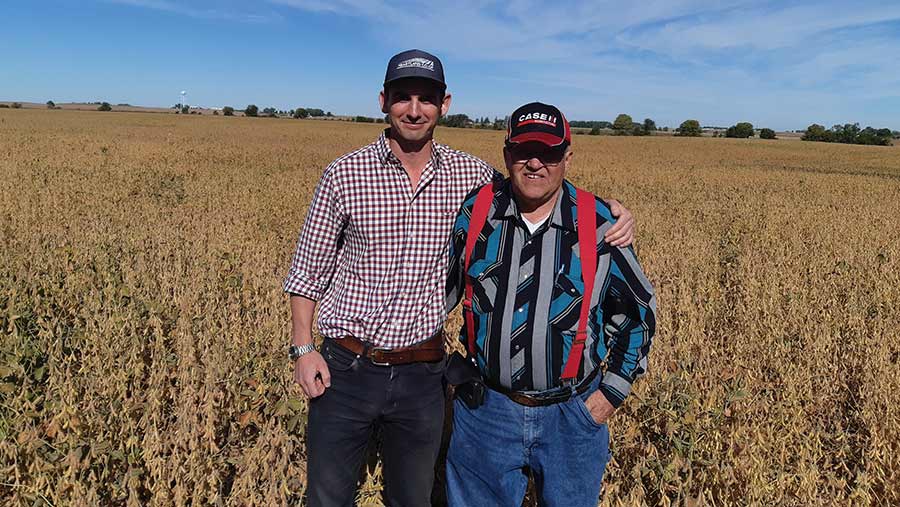Can you farm carbon? One Nuffield scholar seeks answers
 © Nuffield Farming
© Nuffield Farming Can you farm carbon? If so, how do we incentivise it? As farmers face increasing challenges, could “carbon farming” be the solution? These were the questions addressed in agronomist Ben Hunt’s Nuffield Farming Scholarship.
Speaking at this year’s winter conference in Exeter Devon, Ben – who works as a catchment source manager for Wessex Water – challenged the audience to find a commodity with better credentials than carbon.
“Carbon could well be the ultimate commodity. It is invisible, it doesn’t take up space in your shed, there’s no transport, no loading, no packaging or waste.”
See also: What to consider when increasing soil carbon stocks
‘Greenwash’ fears
However, emerging soil carbon markets in the UK have generated a cause for concern within the agricultural industry, particularly surrounding fears of “greenwash” as companies look to offset emissions by purchasing carbon credits from landowners.
One of Ben’s key findings that a shift to carbon insetting rather than offsetting to ensure carbon credits remain in the original supply chains could be a potential solution to overcome the greenwash challenge.
“On the one hand soil carbon markets seem like a win-win,” he continued.
“Agriculture is faced with the triple challenge of rising input costs, the growing threat of environmental regulation and changes in climate.
“As well as neutralising emissions for third-party offsetters, increasing soil carbon (carbon farming) could help farmers cope with future challenges by reducing reliance on inputs, improving weather resilience and environmental performance.”
“On the other hand, it seems fraught with challenges around greenwash, with people often calling it the Wild West.
“Companies are paying farmers to offset their emissions by gaining credit for farmers’ existing actions – a form of greenwashing that farmers risk getting embroiled in.”
Incentivising change

Ben Hunt visiting a US farmer © Ben Hunt
With little market activity in the UK, Ben travelled across Europe and North America as part of his scholarship to discover how to address these challenges and find out whether soil carbon markets held the key to unlocking wide-scale adoption of carbon farming, with its associated benefits.
One of the main issues surrounding carbon markets is the idea of “additionality”, noted Ben.
“For offsets to be genuine, they must have additionality – the sale of carbon credits must be pivotal to a new activity happening. They must incentivise a change,” he said.
“However, I mostly found early adopting regenerative farmers selling carbon credits from practices that had already been adopted.”
This raised early concerns for Ben. Were soil carbon markets merely rewarding existing behaviours without driving change? If so, what was the point of them?
“How can companies offset emissions with practices that were already happening? They had not incentivised anything new,” he said.
The revenue that carbon farmers were earning from the soil carbon market seemed to be relatively small in comparison to the cost that farmers had to incur to implement these farming practices.
This relatively small incentive would therefore mainly be attractive to those farmers already doing those practices, not to those farmers that weren’t – hence the lack of additionality.
“As a result, I identified more risks than opportunities for farmers selling soil carbon credits into the voluntary carbon offset market as farmers were getting embroiled in greenwash.
“In order for carbon markets to drive additional change, the carbon price needs to increase significantly,” he explained.
Five key findings from Ben Hunt’s scholarship
1. Increasing soil carbon could help farmers cut inputs and improve weather resilience
2. Emerging UK soil carbon markets are generating fears of “greenwash” as companies look to offset emissions by purchasing carbon credits from landowners
3. A shift to carbon insetting rather than offsetting to ensure carbon credits remain in the original supply chain could be a solution
4. Currently, Ben identified more risks than opportunities for farmers selling soil carbon credits into the voluntary carbon offset market
5. In order for carbon markets to drive additional change, the carbon price needs to increase significantly
Carbon insetting v offsetting
During his studies, Ben also came across the concept of carbon insetting – the practice of reducing the ‘scope 3’ carbon emissions (emissions associated with the production of raw materials such as grain or milk) within a specific food/beverage supply chain.
In non-offset carbon markets such as insetting, carbon credits are maintained within the value chains. This means any potential risks associated with greenwash and additionality are less of an issue.
“One of the major benefits of insetting is that if a farmer reduces overall net carbon emissions in their farming business, all stakeholders within the supply chain can also claim this emissions reduction for themselves as the benefits are echoed throughout.
“But, most importantly all stakeholders who benefit from this can (at least in theory) share in the cost of the farmer making this change,” said Ben.
For example, if it costs £100 for a dairy farmer to reduce emissions or increase soil carbon sequestration by 1t of carbon dioxide equivalent across the farm, the carbon benefit and the cost of this change can be shared throughout the supply chain.
This is considerably different to the carbon offset markets where a farmer or grower can sell carbon to a company outside of the supply chain such as an airline, enabling them to offset their carbon emissions.
“From this transaction, only two parties benefit – the farmer and the single company that purchased the credits.”
What’s more, the carbon credits have left the supply chain from which they originated.
This puts the agricultural sector and the supply chain at risk as it makes it more difficult for it to meet its own net zero goals, added Ben.
“That’s why I recommend carbon insetting as a safer route for farmers to take when it comes to soil carbon markets in the UK going forwards.
“Insetting has the potential to reward both early- and late-adopters for their carbon and regenerative farming efforts and it offers a solution to additionality issues associated with offsetting,” says Ben.
Conclusion
Rounding up his presentation at the conference, Ben concluded: “Offset soil carbon markets are not the panacea once thought for agricultural transformation, but they could contribute to future solutions alongside regulation, policy, and entrepreneur-led innovation.”
Sustainable farming requires diverse solutions and co-ordinated efforts from industry. In reality, current offset soil carbon markets are not addressing the challenges of additionality and greenwash.
He believes substantially higher carbon pricing is required to drive material change. Otherwise, companies will gain credit for farmers’ existing actions – a form of greenwashing that farmers risk getting embroiled in.
Soil carbon markets may well play a modest future role if integrity and carbon pricing improve.
Currently though, risks seem to outweigh opportunities for farmers. Farmers can mitigate these risks by pursuing non-offset carbon markets such as insetting, which may be a safer route for farmers.
“So, can you farm carbon? Yes, certainly. Adopting carbon farming practices could boost soil carbon with myriad benefits for farmers, climate and the environment.”
But are soil carbon markets a suitable tool to incentivise this soil carbon sequestration?
“Likely not currently, in the case of nascent soil carbon offset markets. If it’s not driving any change in our sector, then it’s also not delivering its intended benefits and we have to ask what the point of it is.
“Although future potential exists if integrity and carbon pricing improve.”
Coming up in the three-part series
- Part 2: Can potatoes be grown regeneratively?
- Part 3: Cover crop opportunities in the UK

